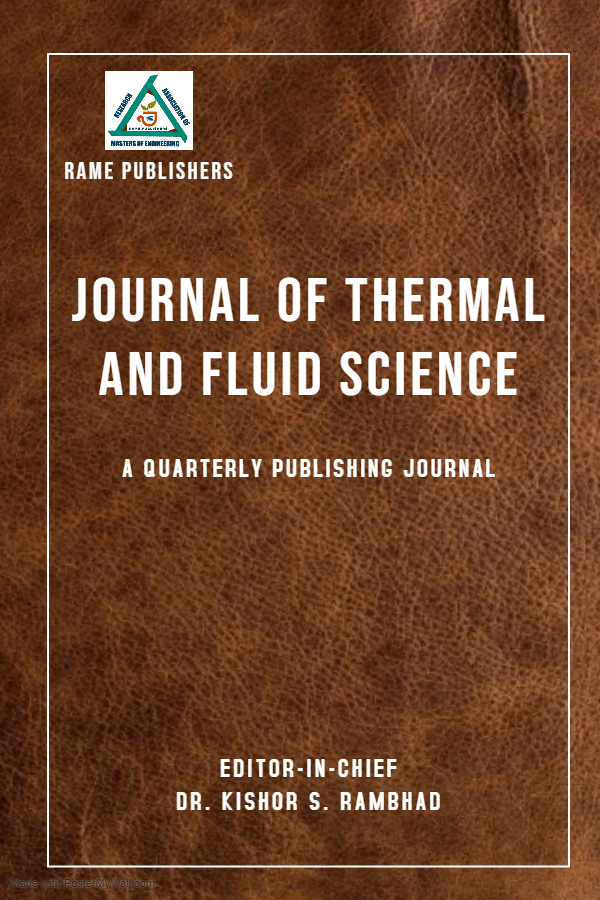Electric Vehicles to be Fueled by Semiconductor Innovation - A Review
Mukund S. Kolambe, Swanand A. Kale, Rohan P. More, Mhalasakant K. Mehakarkar
Journal of Thermal and Fluid Science
Volume 2: Issue 2, July 2021, pp 55-58
Author's Information
Mukund S. Kolambe1
Corresponding Author
1Student, Student, Department of Mechanical Engineering, JSPM Narhe Technical Campus, Pune, Maharashtra, India
mukundkolambe33@gmail.com
Swanand A. Kale2, Rohan P. More2, Mhalasakant K. Mehakarkar2
2Student, Student, Department of Mechanical Engineering, JSPM Narhe Technical Campus, Pune, Maharashtra, India
Abstract:-
To minimize usage of petroleum products (like petrol, diesel) and control environmental pollution, the development of E-Vehicle has been speeding up in many countries. The implementation of EVs is considered a solution to the environmental issues. This paper gives an extensive review of implementation and development of EVs, the charging infrastructure and the technologies. This gives review of the advancement and technologies related to batteries and motors. It depicts the new technologies growing in EV developments and the challenges faced in development of EVs. Various programs and organizations of different countries is described which are involved in growth of EVs.Index Terms:-
Electric motor and control, batteries, Hybrid Electric vehicles, Charging Infrastructure.REFERENCES
- G Xiaoli Sun 1, Zhengguo Li, Xiaolin Wang and Chengjiang Li, “Technology Development of Electric Vehicles: A Review”, Energies, 2020, 13, 90; doi:10.3390/en13010090.
- Krishna Veer Singh, Hari Om Bansal, Dheerendra Singh., “A comprehensive review on hybrid electric vehicles: architectures and components”, Singh, K.V., Bansal, H.O. & Singh, D. A comprehensive review on hybrid electric vehicles: architectures and components”, J. Mod. Transport. 27, 77–107, 2019. https://doi.org/10.1007/s40534-019-0184-3.
- Wentao Jing, Majid Sarvi, Yadan Yan, Inhi Kim, “Electric Vehicles: Review of network modelling and future research needs”, Advances in Mechanical Engineering, SAGE Journals, Volume: 8 issues: 1, January 18 2016. https://doi.org/10.1177/1687814015627981
- K.W.E Cheng, “Recent Development on Electrical Vehicles”, 3rd International Conference on Power Electronics Systems and Applications, IEEE Xplore, July 2009.
- Rakesh Kumar, P. Sanjeevikumar, “Electric Vehicles for India: Overview and Challenges”, IEEE India Info. Vol. 14 No. 2 Apr - Jun 2019.
- L. Boqiang, W. Wei, “Why people want to buy electric vehicle: An empirical study in first-tier cities of China”, Energy Policy 2018, 112, 233–241.
- Nykvist, B., Nilsson, “M. Rapidly falling costs of battery packs for electric vehicles”, Nature Climate Change, Volume 5, 2015, 5, pp. 329–332.
- T. B. Reddy, “Linden’s Handbook of Batteries”, McGraw-Hill: New York, USA, 2011; pp. 167–201.
- Toyota to Make Over 10 Battery EV Models in Early 2020s [https://www.cnbc.com/2017/12/18/toyota-to-make-over-10-battery-ev-models-in-early-2020s.html]
- Paul Krutko, Jay C. Moon, Jeffrey A. Finkle, “Creating the Clean Energy Economy - Analysis of the Electric Vehicle Industry”, International Economic Development Council, 2013.
DOI: 10.1109/PEDG.2015.7223028
- Martin, Mruzek, Igor, Gajdac, Lubos, Kucera, Tomas, Gajdosik. The Possibilities of Increasing the Electric Vehicles Range, Procedia Engineering, Volume 192, 2017, Pages 621-625.
- "Amendments in EV Charging Guidelines by Ministry of Power EV reporter". EV reporter. 7 October 2019. Retrieved 26 May 2020.
- Z. John ShenIchiro, OmuraIchiro Omura, “Power Semiconductor Devices for Hybrid, Electric, and Fuel Cell Vehicles”, Proceedings of the IEEE, Volume 95(4), May 2007, 778 – 789. DOI: 10.1109/JPROC.2006.890118.
- Wael A. Salah, Mahmoud A. M. Albreem, Basim Alsayid, Amir Mohammad Abu AL Aish, “Electric vehicle technology impacts on energy”, International Journal of Power Electronics and Drive Systems, Volume 10(1), March 2019. DOI: 10.11591/ijpeds.v10.i1.pp1-9
- TANAKA Precious Metals, Electric Vehicles and the Semiconductor Boom, October 8, 2018. Available at: https://industrytoday.com/electric-vehicles-and-the-semiconductor-boom/
- Alvaro Masias, James Marcicki, and William A. Paxton, “Opportunities and Challenges of Lithium-Ion Batteries in Automotive Applications”, ACS Energy Letters 2021 6 (2), 621-630. DOI: 10.1021/acsenergylett.0c02584.
- Siqi Li, and Chunting Chris Mi, “Wireless Power Transfer for Electric Vehicle Applications”, IEEE Journal of Emerging and Selected Topics in Power Electronics, Vol. 3, No. 1, March 2015.
- Falan Yinug, Semiconductor Shortage Highlights Need to Strengthen U.S. Chip Manufacturing, Research, Feb 04, 2021. Available at: semiconductors.org/semiconductor-shortage-highlights-need-to-strengthen-u-s-chip-manufacturing-research/
To view full paper, Download here
To View Full Paper
For authors
Author's guidelines Publication Ethics Publication Policies Artical Processing Charges Call for paper Frequently Asked Questions(FAQS) View All Volumes and IssuesPublishing with




